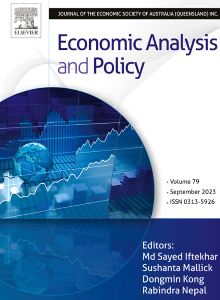极端高温对地方政府债务规模空间关联网络的影响研究
IF 8.7
2区 经济学
Q1 ECONOMICS
引用次数: 0
摘要
基于2010-2022年中国地级地方政府债务规模的空间相关性,采用二次分配程序(QAP)、自相关随机化检验(Joint-Count)和指数随机图模型(ERGM)等复杂网络模型,研究了极端高温对地方政府债务规模空间相关性网络的影响。研究结果表明,极端高温与债务规模的空间关联网络之间的关系越来越强。具体而言,极端高温通过极端高温的空间分布特征和公众对极端温度的关注,正向影响债务规模的空间中心性,促进债务规模的空间溢出效应。此外,极端高温通过强化马太效应的散度动态,成为债务尺度空间相关网络演化的驱动力。它导致高负债城市吸引了不成比例的更多债务规模相关性。进一步的研究表明,其对债务网络演化的影响呈现出马修效应先增强后饱和的非线性模式,但始终是一个积极的驱动因素。同时,由于具有相似气候条件的城市的债务规模相关性增强,观察到分类混合效应。本研究为制定应对极端高温等气候变化的地方政府债务空间布局和管理策略提供了有价值的见解,有助于增强债务管理体系的气候融资弹性。本文章由计算机程序翻译,如有差异,请以英文原文为准。
Research on the impact of extreme high temperature on the spatial correlation network of local government debt scales
Based on the spatial correlation of Chinese prefecture-level local government debt scales from 2010-2022, this paper employs complex network models, including Quadratic Assignment Procedure (QAP), Randomization Test of Autocorrelation (Joint-Count) and Exponential Random Graph Model (ERGM) to investigate the impact of extreme high temperature on the spatial correlation network of local government debt scales. The research findings reveal a strengthening relationship between extreme high temperature and the spatial correlation network of debt scales. Specifically, extreme high temperature positively affects the spatial centrality of debt scales and promotes their spatial spillover effect, mediated through the spatial distribution characteristics of extreme high temperature and public concerns regarding these temperature extremes. Furthermore, extreme high temperature emerges as the driving force for the evolution of spatial correlation network of debt scales by intensifying the Matthew effect’s divergence dynamics. It leads high-debt cities to attract disproportionately more debt scale correlations. Further investigation reveals that its impact on debt network evolution demonstrates a nonlinear pattern of Matthew effect intensification followed by saturation, while consistently serving as a positive driving factor. Simultaneously, an assortative mixing effect is observed, as the debt scale correlations of cities with similar climate conditions are enhanced. This research provides valuable insights for the formulation of spatial layout and management strategies of local government debt to cope with climate change such as extreme high temperature, and contributes to enhancing the climate finance resilience of debt management system.
求助全文
通过发布文献求助,成功后即可免费获取论文全文。
去求助
来源期刊

Economic Analysis and Policy
ECONOMICS-
CiteScore
9.80
自引率
9.20%
发文量
231
审稿时长
93 days
期刊介绍:
Economic Analysis and Policy (established 1970) publishes articles from all branches of economics with a particular focus on research, theoretical and applied, which has strong policy relevance. The journal also publishes survey articles and empirical replications on key policy issues. Authors are expected to highlight the main insights in a non-technical introduction and in the conclusion.
 求助内容:
求助内容: 应助结果提醒方式:
应助结果提醒方式:


